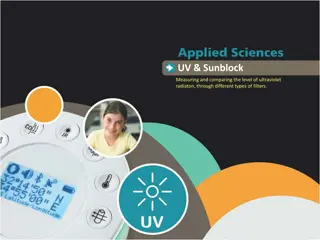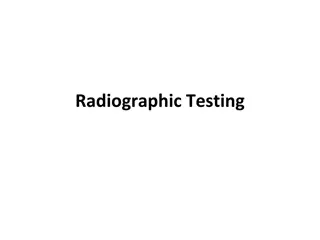Understanding Radiation and UV Rays: Risks and Impact
Radiation, in the form of waves or particles, can be ionizing and harmful. Ultraviolet (UV) rays from the sun, particularly UVA and UVB, can lead to skin damage, premature skin aging, and increase the risk of skin cancers. Protecting oneself from UV exposure and understanding the UV Index can help minimize the risks associated with solar radiation.
Download Presentation

Please find below an Image/Link to download the presentation.
The content on the website is provided AS IS for your information and personal use only. It may not be sold, licensed, or shared on other websites without obtaining consent from the author. Download presentation by click this link. If you encounter any issues during the download, it is possible that the publisher has removed the file from their server.
E N D
Presentation Transcript
What is radiation? Radiation is the emission of energy in the form of waves or particles Radiation that is so powerful that it can remove electrons from atoms is called ionizing. Examples of types of ionizing radiation are x- rays from medical machines and gamma rays from radioactive substances.
Radiation Ultraviolet (UV) rays are a form of invisible energy given off by the sun Ultraviolet radiation is divided into 3 wavelength ranges: UVA rays cause skin cells to age and can cause some damage to cells' DNA. They are mainly linked to long-term skin damage such as wrinkles, but are also thought to play a role in some skin cancers.
UVB rays are mainly responsible for direct damage to the DNA, If this damage affects the DNA of genes that control skin cell growth, skin cancer may be the result and are the rays that cause sunburns . UVC rays don't penetrate our atmosphere and therefore are not present in sunlight.
unprotected exposure to UV rays can lead to: sunburn prematurely aged skin wrinkles loss of skin elasticity dark patches pre-cancerous skin changes (such as dry, scaly, rough patches called actinic keratoses). Skin cancers
Skin cancers Basal cell cancers and squamous cell cancers are the most common cancers of the skin. They develop from skin cells called keratinocytes found mainly on parts of the body exposed to the sun, such as the head and neck their occurrence is related to the amount of sun exposure over a person's lifetime.
The UV Index The amount of UV light reaching the ground in any given place depends on a number of factors, including the time of day, time of year, elevation, and cloud cover The UV Index number, on a scale from 1 to 11+, is a measure of the amount of UV radiation reaching the earth's surface during an hour around noon.
Every day the National Weather Service calculates the predicted UV Index for the next day in each area of the U.S. If the level of solar UV radiation is predicted to be unusually high, the risk of overexposure is greater than normal
High risk gps are those who : have lots of moles, irregular moles, or large moles have freckles and burn have fair skin or blond, red, or light brown hair were previously treated for skin cancer have a family history of skin cancer, especially melanoma
live at high altitudes (UV radiation increases 4% to 5% for every 1,000 feet above sea level) live in tropical or subtropical climates work indoors all week and then get intense sun exposure on weekends. spend a lot of time outdoors have certain autoimmune diseases, such as systemic lupus erythematosus
Take medicines that could increase your sensitivity to sunlight (oral contraceptives , tetracycline, sulfa drugs , phenothiazines (major tranquilizers tricyclic antidepressants thiazide diuretics sulfonylureas (a form of oral anti-diabetic )
steps to limit amount of exposure to UV rays: Long-sleeved shirts, long pants, or long skirts cover the most skin and are the most protective Dark colors generally provide more protection than light colors If you can see light through a fabric, UV rays can get through too Children's swimsuits made from sun-protective fabric and designed to cover the child from the neck to the knees are popular in Australia
Use a sunscreen with a sun protection factor (SPF) of 15 or higher (number represents the level of protection against UVB rays provided by the sunscreen -- a higher number means more protection When using an SPF 15 and applying it correctly, you get the equivalent of 1 minute of UVB rays for each 15 minutes you spend in the sun. So, 1 hour in the sun wearing SPF 15 sunscreen is the same as spending 4 minutes totally unprotected )
Sunscreen products labeled "broad- spectrum" protect against UVA and UVB Be sure to apply the sunscreen properly. Most recommend applying sunscreen generously to dry skin 20 to 30 minutes before going outside so your skin has time to absorb the chemicals. If you're going to wear insect repellent or makeup, apply the sunscreen first
Be generous. About 1 ounce of sunscreen (a "palmful") should be used to cover the arms, legs, neck, and face of the average adult. most sunscreens must be reapplied at least every 2 hours and even more often if you are swimming or sweating Wear a hat
Wear sunglasses that block UV rays Darker glasses are not necessarily better because UV protection comes from an invisible chemical applied to the lenses, not from the color or darkness of the lenses Large-framed sunglasses are more likely to protect your eyes from light
Limit direct sun exposure during midday usually between the hours of 10 am and 4 pm. If your shadow is shorter than you, the sun's rays are the strongest Be especially careful on the beach and in the snow because sand and snow reflect sunlight, increasing the amount of UV radiation you receive.
If you plan to be outdoors, you may want to check the UV Index for your area. The UV Index usually can be found in the local newspaper or on TV and radio news broadcasts Examining your skin :It's important to check your own skin, preferably once a month
A self-exam is best done in a well-lit room in front of a full-length mirror The first time you inspect your skin, spend a fair amount of time carefully going over the entire surface of your skin. Learn the pattern of moles, freckles, and other marks on your skin so that you'll notice any changes next time
Basal cell cancers and squamous cell cancers are most often found in areas that get exposed to a lot of sun, such as the head, neck, and arms, but they can occur elsewhere. Look for new growths, spots, bumps, patches, or sores that don't heal after 2 to 3 months
Basal cell carcinomas often look like flat, firm, pale areas or small, raised, pink or red, translucent, shiny, waxy areas that may bleed after a minor injury.
Squamous cell carcinomas may look like growing lumps, often with a rough, scaly, or crusted surface. They may also look like flat reddish patches in the skin that grow slowly.
It's important to know the difference between melanoma and a harmless mole. A normal mole is most often an evenly colored brown, or black spot on the skin. It can be either flat or raised. It can be round or oval. Moles are usually less than 1/4 inch across. Moles can be present at birth or they can appear later. Several moles can appear at the same time.
Once a mole has developed, it will usually stay the same size, shape, and color for many years. Moles may fade away in older people
Melanomas The "ABCD rule A is for ASYMMETRY: One half of a mole does not match the other. B is for BORDER: The edges are irregular, ragged, notched, or blurred. C is for COLOR: The color is not the same all over and may include shades of brown or black, or sometimes with patches of pink, red, white, or blue
D is for DIAMETER: The spot is larger than 6 millimeters across (about inch), although melanomas can sometimes be smaller than this Other warning signs are: redness or a new swelling beyond the border change in sensation -- itchiness, tenderness, or pain
change in the surface of a mole -- scaliness, oozing, bleeding, or the appearance of a bump or nodule a mole that looks very different from your other moles spread of pigment from the border of a spot to surrounding skin a sore that does not heal























